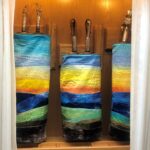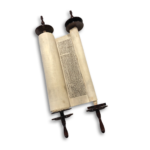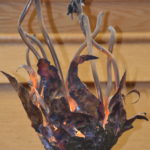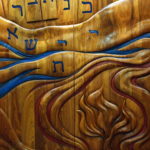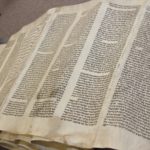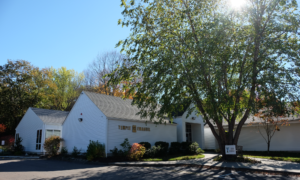 Temple Emanuel began with a group of Reform Jews who were seeking a better quality of Jewish education for their children, as well as an experience different from what they found in typical Reform congregations. The year was 1962, and the founding “mother” and “father” of the congregation were Lois and Paul Levine. First meetings and services were in their home, and the group later moved to sharing space with the Unitarian Universalist Society of New Haven and then the Whitney Avenue Women’s Club. At that time, the synagogue was known as the New Haven Jewish Association.
Temple Emanuel began with a group of Reform Jews who were seeking a better quality of Jewish education for their children, as well as an experience different from what they found in typical Reform congregations. The year was 1962, and the founding “mother” and “father” of the congregation were Lois and Paul Levine. First meetings and services were in their home, and the group later moved to sharing space with the Unitarian Universalist Society of New Haven and then the Whitney Avenue Women’s Club. At that time, the synagogue was known as the New Haven Jewish Association.
The name was changed to Temple Emanuel when we applied for membership with the UAHC and obtained a Holocaust Torah scroll. Some members wanted less Hebrew; some wanted less politics; others wanted a smaller, more congenial group. Founded in diversity and individualism, our current congregation continues that tradition.
Temple Emanuel was initially led by a student rabbi, Bob Goodman, and then later by another student rabbi, Mark Winer, who was accompanied on guitar by Les Bronstein. Later, the congregation grew sufficiently to seek our own space. Our current location was purchased, and renovations of the buildings ensued. The former metal cattle shed, or “the barn,” was shoveled, cleaned, remodeled, etc., by congregants, and became our sanctuary. Tractors and farm implements were removed. The “house” became the office and school building, as well as housing various caretakers over the years. Rabbi Winer became the first full-time, ordained rabbi, and remained our spiritual leader until 1977, when Rabbi Gerald Brieger was hired. Through an involved process, drawing upon members knowledgeable about architecture, design, and finances, and others caring strongly about planning the growth of our synagogue, our new sanctuary was conceived and built, with completion in 1991. Rabbi Winer had introduced the concept of “services in the round,” with movable chairs to fit the occasion. Services were participatory, with animated questions and discussions, and a self-published Siddur. This style of worship continued under Rabbi Brieger’s leadership, with a more current version of our Siddur, continuing to have movable chairs with arrangements to fit the occasion.
For a community of individualists, who continued to want, even demand, different things, Rabbi Brieger was a fitting choice. A former NFTY song leader, he had strong roots in the Reform movement, excellent musical skills, and an informal style of leadership. Through songs taught to congregants, more Hebrew was introduced, in a form most could accept. Over time, our spirited singing and the increased proportion of Hebrew in our services had some of us thinking we were “Chasidic Reform” Jews. Guests from Conservative synagogues and new members from more traditional backgrounds readily found homes within our rubric. Rabbi Jerry was always willing to share the bima, and his openness and approachability led to the development of strong lay leadership within the synagogue. Through his mentorship and inspiration, always encouraging people to do new things, there have been several adult B’nai Mitzvah classes, out of which have come some continuing Torah and Haftorah chanters/readers, some of whom have gone on to mentor and inspire others to follow suit. Members who wish to do so can give Shabbat D’var Torah, and participate in services in a variety of ways. Rabbi Brieger retired in June 2009, after a “marriage” of 32 years. Rabbi Michael Farbman became the new rabbi of Temple Emanuel in July, 2009. Once per year, the rabbi has rested on Shabbat, become a congregant, while the women of the Sisterhood conduct an entire service, often involving a complete Torah service. The Sisterhood has been strong in terms of fundraising, and generously contributes to the well-being and enhancement of the synagogue. Of note, our Holocaust Torah is beautifully displayed in the foyer, an area of the synagogue jointly enhanced by contributions of the Sisterhood and one of our generous member families.
Variety in adult programming has added to the intellectual and social lives of our members. For many years, we have held a Scholar in Residence Weekend, where we learned about historical, liturgical, religious, spiritual, musical and intellectual topics related to Judaism. In spring 2008, we hosted the first interfaith Scholar in Residence Weekend, with participants from six congregations in Orange, CT—Catholic, Episcopal, Greek Orthodox, Congregational, Conservative Judaism, and us. All of us enjoyed learning from a renowned rabbi and archeologist, Dr. Richard Freund. We look forward to more joint adult educational programming in the future, in addition to our annual, Interfaith Thanksgiving service, with the locations rotating amongst us, and joint Selichot services with the other Reform congregations in our area.
Providing a Reform Jewish education has been a main draw for many of our congregational families and many of our teachers have been congregants. Some of the student alumni of our school continue as student aides, passing along their knowledge and love of Jewish learning to those following them. We were blessed by the leadership of Susan Pinsky Bleeks, who headed the school for nearly 25 years. As of summer 2017 our very own Olga Markus became the Religious School director.
Most of all, our sense of community has continued. From the beginning, when some people in the larger area reportedly referred to us as “those hippies in the woods,” the warmth and communal spirit of the membership has been very strong. In happy times, times of sadness, through illnesses and accidents, we have pulled together to help one another. Meals are delivered, rides are provided, visits occur, etc. Some of our long-time members have preferred to call our synagogue “B’nai Warm,” in keeping with how most new members are greeted, welcomed, and enfolded. It is almost axiomatic that, whenever new faces are spotted at Shabbat services or educational programs, members come to welcome them, curious to learn about our visitors. A goodly proportion of those visitors eventually join our community, almost always commenting on how they were initially welcomed, quickly feeling more like friends than strangers.
Our concern for others extends far beyond the borders of our own synagogue. Tikkun Olam and Social Action have always been strong component of our communal fabric. Among such pursuits, members of Temple Emanuel cooperatively collect and donate food for local food pantries several times per year, often surpassing similar collections in larger organizations. Goods have been sent to people in other countries through our involvement in Sister City projects, and we staff a local soup kitchen the third Sunday of each month. Our religious school children have regular Tzedakah projects, including gift baskets for children residing in New Haven’s domestic violence shelter, collecting books and school supplies for various children”s programs, raising money for animal shelters, and planting a tree as a 9/11 memorial. A significant contingent from our congregation attended the April 30, 2006 rally on the Capitol Mall in Washington, DC, for the people of Darfur, braving the twelve hour round trip bus ride. A Temple delegation will travel to Leon, Nicaragua through the New Haven/Leon Sister City Project in August 2009.
So, we’ve grown considerably, spiritually, communally, and personally. We intend to keep the spirit, warmth, diversity, and lively debates that have always been part of our ethos. Temple Emanuel has never been an “inside the box” community, and we will never strive to be.
As part of our 50th anniversary in 2012 a great number of TE members were interviewed and many stories were gathered. We are delighted to be able to offer you an opportunity to see the very special video that was created as a result.
In addition, a booklet of TE history was published as part of our 50th anniversary celebration.
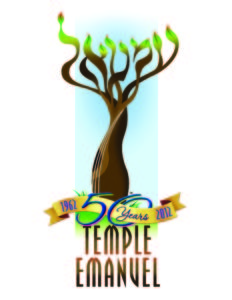
TORAHS OF TEMPLE EMANUEL
by Peter Stolzman For most Jews, the Torah elicits a variety of feelings and meanings. The scrolls we use in our worship services teach us the lessons and history of the Hebrew people. Some think of the Torah as the divine word of G-d, others feel it is a chronological history of the beginnings of … Continue reading “TORAHS OF TEMPLE EMANUEL”
Temple Emanuel Memorial Torah Scroll #1178 – back in our Ark!
Temple Emanuel houses in our Ark the Holocaust Memorial Scroll #1178, a scroll that belonged to the destroyed Jewish community of Horazdovice, Czechoslovakia, a community that perished in the flames of the Holocaust. This scroll is one of several hundred Czech Torah scrolls that survived the Holocaust, eventually coming to the Westminster Synagogue in London, … Continue reading “Temple Emanuel Memorial Torah Scroll #1178 – back in our Ark!”
The Ner Tamid and other metal works of art at Temple Emanuel by Gary Rappaport
Shortly after my daughter Rebecca was born in 1971 and my family moved to Orange Connecticut, I finally found a synagogue that I loved going to and coincided with my Jewish philosophy. I volunteered for many different projects at TE. Among them was remodeling the barn, remodeling the house, serving in many different ways such … Continue reading “The Ner Tamid and other metal works of art at Temple Emanuel by Gary Rappaport”
Temple Emanuel Ark Doors
The beautiful doors to the Temple Emanuel ark were created in 1988. The artist, Candy Knapp, collaborated with Rabbi Jerry Brieger to create the meaningful and interesting design. The project was brought together by Rise Siegel. On the upper left corner of the doors is the tablet of the 10 Commandments. In the lower right … Continue reading “Temple Emanuel Ark Doors”
Holocaust Memorial Torah Scroll #1178 from Horazdovice, written in 1880
There is a very special Torah scroll that we have at Temple Emanuel. It used to live in our Ark, together with other Torah scrolls, and generations of TE bar and bat mitzvah students read from this very scroll on their special day. A powerful symbol of Jewish survival and continuity, this scroll was lovingly … Continue reading “Holocaust Memorial Torah Scroll #1178 from Horazdovice, written in 1880”
